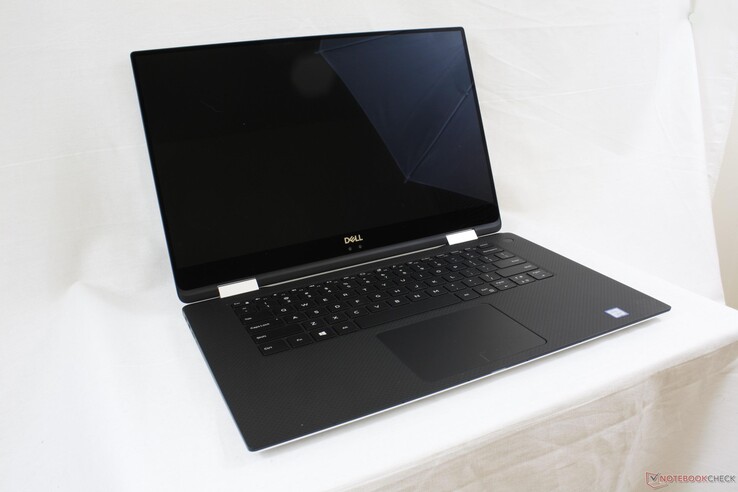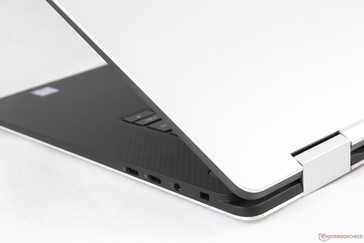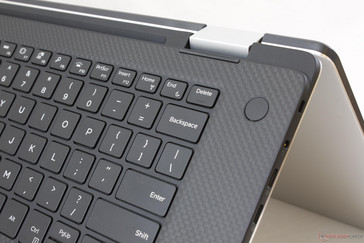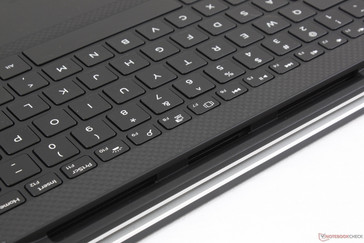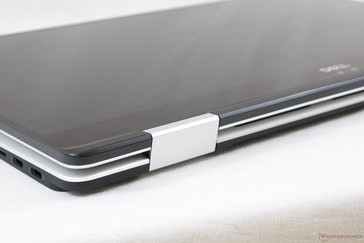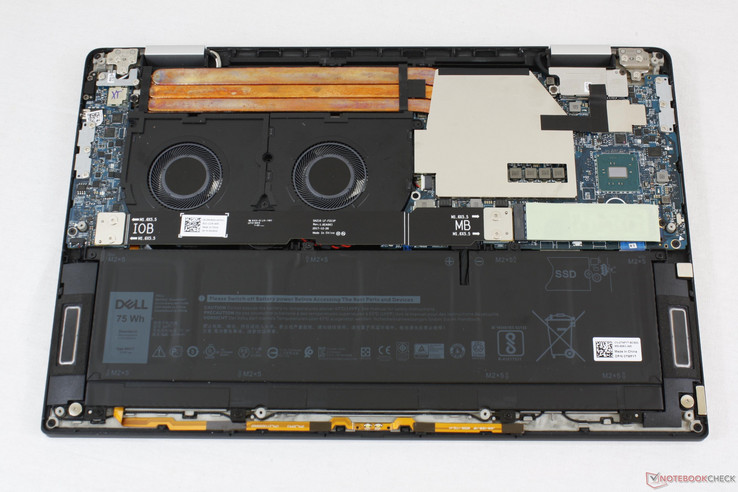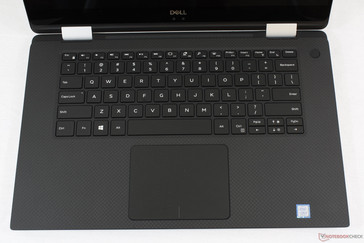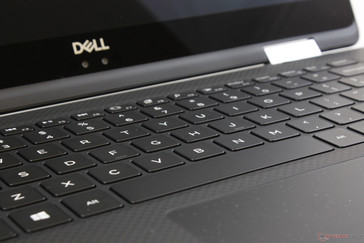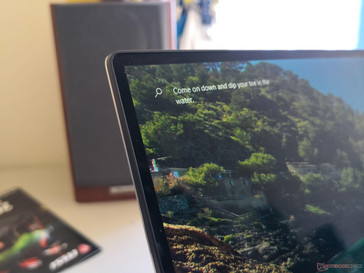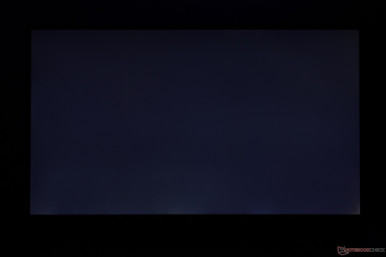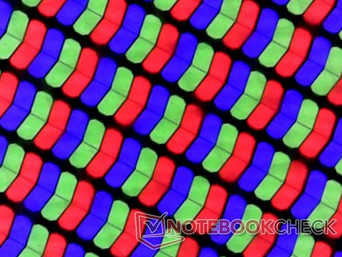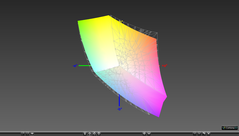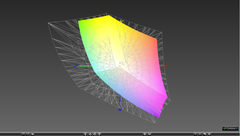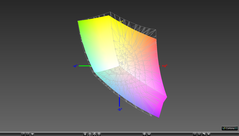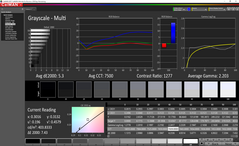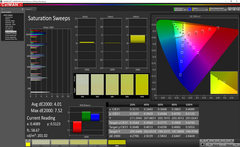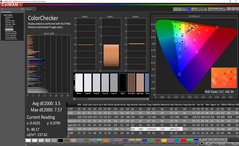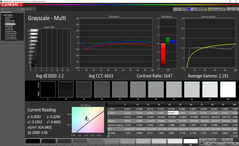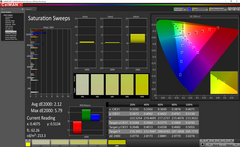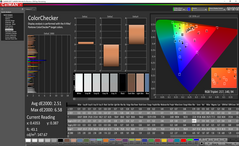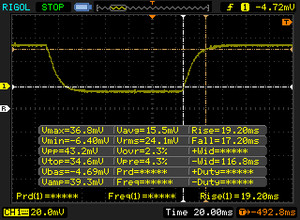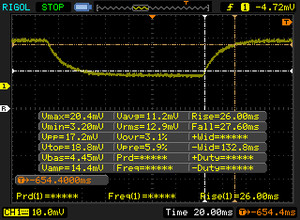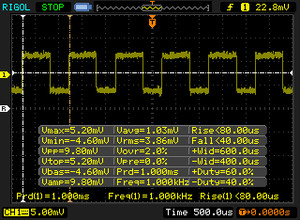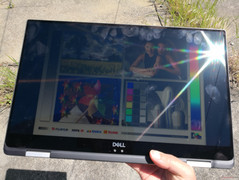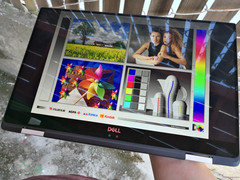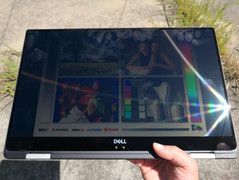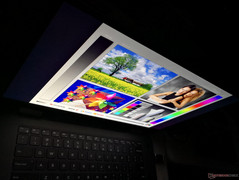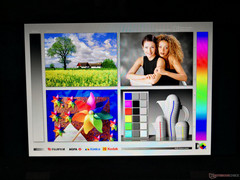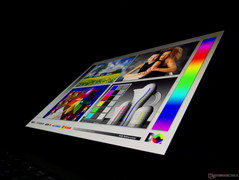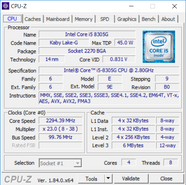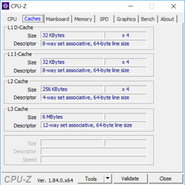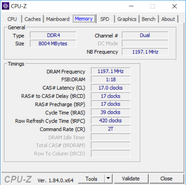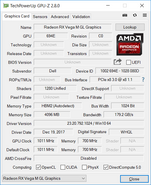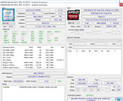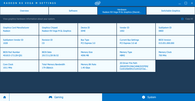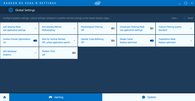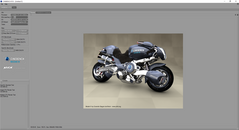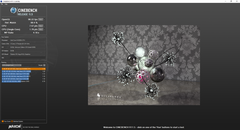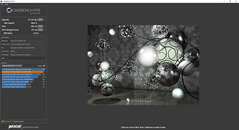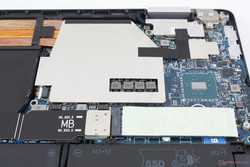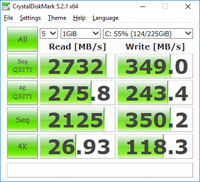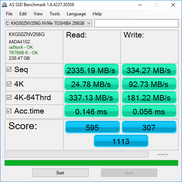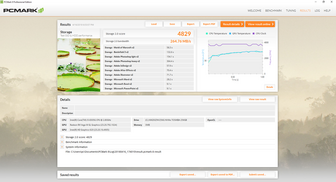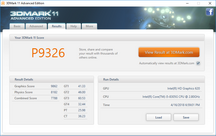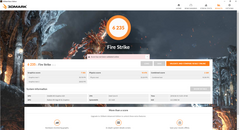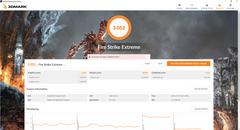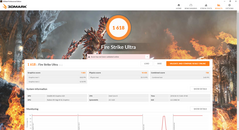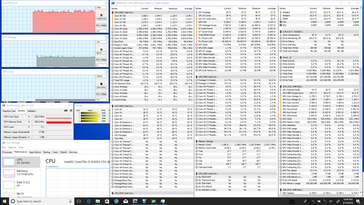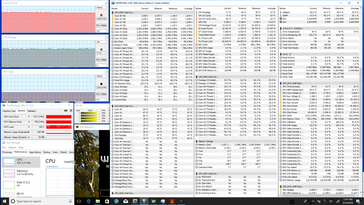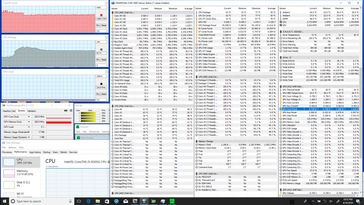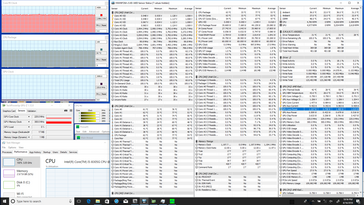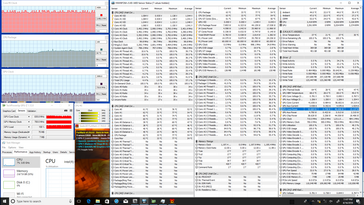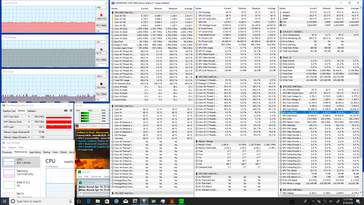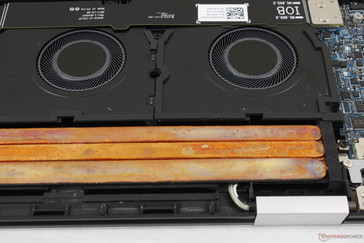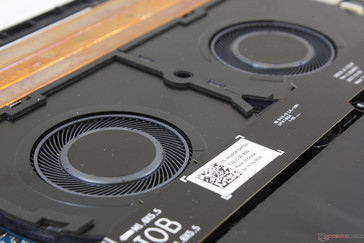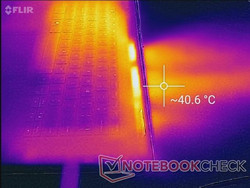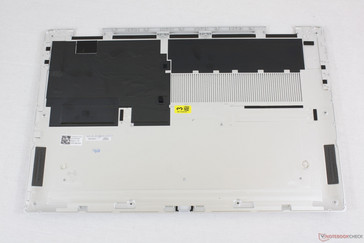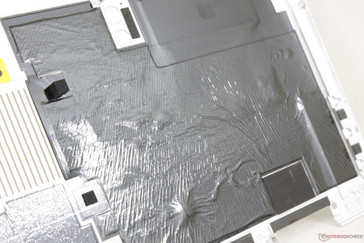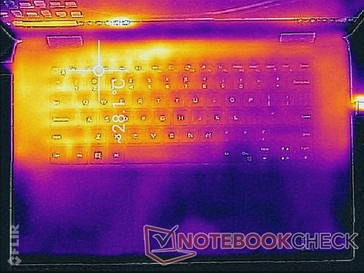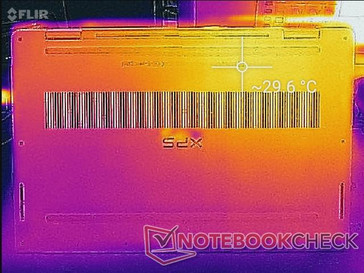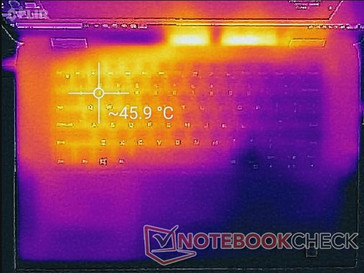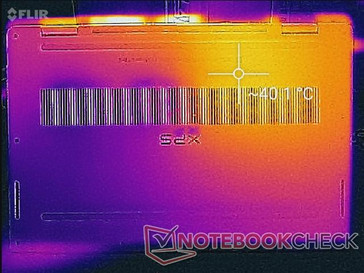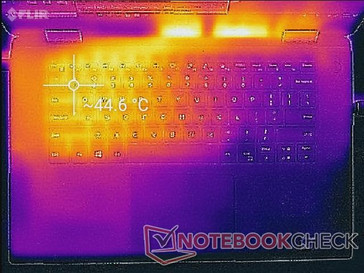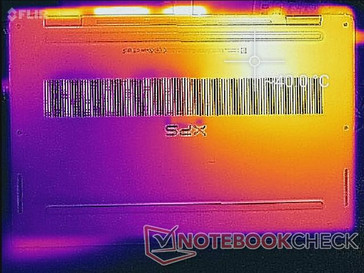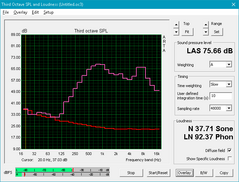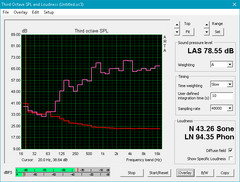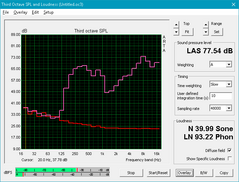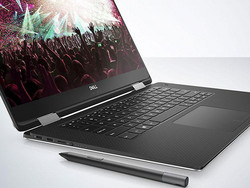Dell XPS 15 9575 (i5-8305G, Vega M GL, FHD) Convertible Review

A key highlight from Dell's CES conference this year was the introduction of the XPS 15 convertible. While it's not the first XPS system to get the 2-in-1 treatment or even Dell's first 15.6-inch convertible, it stands out as being the first notebook designed specifically with Kaby Lake-G in mind. The manufacturer's decision to completely omit GeForce GPUs and both Intel U-Series and HQ-series of CPUs from the XPS 15 2-in-1 lineup says a lot about Dell's faith in the Frankenstein product produced by the unorthodox partnership between Intel and AMD.
The XPS 15 9575 is currently limited to four SKUs split between two SoCs (Core i5-8305G and Core i7-8705G), two resolution options (FHD and 4K UHD), and two DDR4-2400 RAM sizes (8 GB and 16 GB) with prices ranging from $1500 USD to as much as $2200 USD. In contrast, the XPS 15 9560 starts at just $1000 USD. It's important to note that the same Radeon RX Vega M GL GPU with 4 GB of HBM2 VRAM is shared across all SKUs and that system RAM is soldered unlike on the regular XPS 15 9550/9560 series. Our test model today is the entry-level configuration with higher-end options further down our list for when we inevitably revisit the series on a future date.
Direct competitors to the new Dell convertible are the 15.6-inch HP Spectre x360 15 series, Acer Nitro 5 Spin series, Lenovo Yoga 720, Asus Zenbook Flip 15, and the Microsoft Surface Book 2 detachable. All of these alternatives have similar 2-in-1 properties but with discrete GeForce MX150/1050/1060 GPUs for a similar level of performance.
Before we begin, we should note that the default AC adapter included with our test unit appeared faulty and was unable to charge our system. As a result, we relied on a generic 45 W adapter for all of our benchmark tests and data collection. Key data like charging time and power consumption would have been wholly inaccurate without the default adapter and so we have omitted these sections completely from this review.
April 26, 2018 Update: Our test model includes no accessories, but retail units will come with an active stylus pen and a USB Type-C to USB 3.0 Type-A adapter at no additional costs. We've corrected the review to reflect this.
| XPS 15 9575 | XPS 15 9560 | |
|---|---|---|
| CPU | Core i5-8305G, Core i7-8705G (Kaby Lake-G only) | Core i3-7100H, Core i5-7300HQ, Core i7-7700HQ |
| GPU | AMD Radeon RX Vega M GL w/ 4 GB HBM2 VRAM | Integrated HD Graphics 630 or GeForce GTX 1050 w/ 4 GB GDDR5 VRAM (Optimus) |
| RAM | Soldered, 8 GB or 16 GB DDR4-2400 | Upgradeable 2x SODIMM, up to 32 GB DDR4-2400 |
| Display | FHD glossy, 4K UHD glossy w/ 100 percent AdobeRGB, Forced touchscreen | FHD matte, 4K UHD glossy w/ 100 percent AdobeRGB, Optional touchscreen |
| Storage | 1x M.2 2280 slot only, Upgradeable | 1x M2 2280 + 1x 2.5-inch SATA III, Upgradeable |
| Keyboard | Maglev, 0.7 mm travel, Backlit | Membrane-based, 1.3 mm travel, Backlit |
| Touchpad | Identical to XPS 15 9560 | Precision trackpad |
| Speakers | 1 W x 2 (Stereo) | Stereo |
| Camera | Identical to XPS 15 9560 | 720p, Bottom of display |
| Connectivity | 2x Thunderbolt 3 (full-lane), 2x USB Type-C 3.1, MicroSD reader, 3.5 mm combo audio, Noble Lock | 2x USB 3.0 Type-A, 1x HDMI, 1x Thunderbolt 3 (half-lane), full-size SD reader, Noble Lock |
| Weight | 2+ kg | 1.8+ kg |
| Dimensions | 354 x 235 x 16 mm | 357 x 235 x 17 mm |
| MSRP | $1500 USD to $2200 USD | $1000 USD to $2000 USD |
Case
The XPS 15 convertible manages to maintain the distinct matte look and smooth feel of the standard XPS 15 9560 that we have become familiar with. The aluminum and carbon materials are identical and so is the impressive rigidity of the design. Attempting to twist the base or lid results in only minimal warping and both the center of the keyboard and outer lid are also equally strong. This is one of the few laptops where the lid feels almost as good as the base as far as flexibility is concerned.
Build quality is excellent on our unit with no unintended gaps or defects between materials and only very slight creaking if bending its surfaces. Comparisons to the Spectre x350 15 are unavoidable, but we would have to give the slight edge to Dell as the XPS 15 9575 leaves a stiffer overall impression especially in regards to the hinges. There really isn't much to complain about the chassis even when nitpicking.
Our small but notable gripe is that there is no notch on the front edge of the system when the lid is closed. Opening the display becomes more difficult than it should be even with both hands. Furthermore, the black carbon fiber surfaces readily attract grease and suffer from the same visual disadvantages as on the XPS 15 9560 where its surfaces will become unattractively glossy over time from oil buildup. Unfortunately, the XPS 15 9575 does not carry the same White and Rose Gold option as on the latest XPS 13 9370 to avoid this issue.
In terms of size and weight, the XPS 15 9575 is ever so slightly thinner than the XPS 15 9560 (16 mm vs. 17 mm) while weighing very nearly the same. Its footprint is also similar to the standard XPS 15 while being shorter than the competing Spectre x360 15 since the bezel on the HP is longer along the top edge to preserve webcam placement. Still, a 15.6-inch 2 kg convertible is far too clunky to be used as a regular tablet and so the XPS 15 9575 is therefore best used at home or when sitting down for ergonomic reasons.
Connectivity
Be prepared for a generation of laptops with no USB Type-A ports. Despite its large 15.6-inch screen size, the convertible carries only USB Type-C/Thunderbolt 3 and a 3.5 mm audio jack. As flexible and desirable Thunderbolt 3 may be, an adapter or dongle will be necessary for nearly all peripherals. In comparison, the Spectre x360 15 and Acer Nitro 5 both carry USB Type-A and even full-size HDMI ports for more convenience.
The saving grace for the XPS are its full-lane (4x PCIe) dual Thunderbolt 3 ports along the left edge. We would've preferred to have one Thunderbolt 3 port on each side for more versatility in docking arrangements instead of having both Thunderbolt ports so close together. Nonetheless, it's clear that Dell is pushing the use of optional dongles like the DA200 while its closest competitors are still able to offer a wider variety of integrated ports.
SD Card Reader
Dell has dropped the full-size SD reader in favor of a spring-loaded MicroSD reader. Fortunately, transfer rates still support UHS-II standards for speeds of over 200 MB/s compared to only ~80 MB/s on the LG Gram 13. Moving 1 GB worth of images from our test card to desktop takes just 7 seconds.
| SD Card Reader | |
| average JPG Copy Test (av. of 3 runs) | |
| HP Spectre x360 15t-bl100 (Toshiba Exceria Pro SDXC 64 GB UHS-II) | |
| Dell XPS 15 9575 i5-8305G (Toshiba Exceria Pro M501 UHS-II) | |
| Dell XPS 15 9560 (i7-7700HQ, UHD) (Toshiba Exceria Pro SDXC 64 GB UHS-II) | |
| maximum AS SSD Seq Read Test (1GB) | |
| Dell XPS 15 9560 (i7-7700HQ, UHD) (Toshiba Exceria Pro SDXC 64 GB UHS-II) | |
| HP Spectre x360 15t-bl100 (Toshiba Exceria Pro SDXC 64 GB UHS-II) | |
| Dell XPS 15 9575 i5-8305G (Toshiba Exceria Pro M501 UHS-II) | |
Communication
All SKUs ship with the same Killer 1435 WLAN module that is identified as the Qualcomm QCA6174 by hardware analysis tools. The new XPS 13 9370 also ships with this exact same module as standard. We did not experience any connectivity issues or dropouts during our time with the unit. More details on specific Killer features can be found on our dedicated review of the Killer 1535 WLAN module.
| Networking | |
| iperf3 transmit AX12 | |
| Dell XPS 15 9575 i5-8305G | |
| Dell XPS 15 9560 (i7-7700HQ, UHD) | |
| LG Gram 15Z975 | |
| iperf3 receive AX12 | |
| Dell XPS 15 9560 (i7-7700HQ, UHD) | |
| LG Gram 15Z975 | |
| Dell XPS 15 9575 i5-8305G | |
Accessories
Dell has informed us that there will be no paper manuals included in the box since everything can be downloaded online here. Still, a free USB Type-C adapter to Type-A, RJ-45, HDMI, or anything else would have been appreciated especially since the system has nothing outside of its 4x USB Type-C ports. Competitors like HP and Asus frequently include USB Type-C adapters at no extra charge.
Correction: Retail units will indeed ship with a USB Type-C to USB Type-A adapter and an active stylus pen.
Maintenance
The bottom panel requires the same T5 hex wrench as the standard XPS 15 and care must be taken when servicing as the metal plate is very sharp around the edges and corners. Users are granted direct access to the cooling solution, M.2 2280 SSD, and internal battery while the interposer must be removed to expose the BIOS battery. RAM is unfortunately soldered to limit expandability.
Warranty
The standard one-year limited warranty applies. As usual, Dell has very extensive options with up to four years of coverage as they are one of the largest PC manufacturers worldwide.
Please see our Guarantees, Return Policies and Warranties FAQ for country-specific information.
Input Devices
Keyboard
The unique and vaunted backlit Maglev keyboard is Dell's attempt at offering a MacBook Pro-like typing experience for a Windows laptop. It aims to provide a very shallow key travel of just 0.7 mm compared to 1.5 mm on the Spectre x360 15 while maintaining a firm and satisfactory click when pressed. In practice, the keys take some getting used to. Presses are significantly quieter and with less clatter than most Ultrabooks, but the very short travel makes each key feel very light even though feedback is relatively firm. It doesn't take much force to press a key and so we found ourselves hitting some keys by accident. We don't see it as being any better or worse than the keyboard of the XPS 15 9560 in terms of tactility as they each have thier own pros and cons.
Another side effect from the short travel is that gaming can feel very awkward as both membrane-based keys and mechanical keys are typically deeper and not as light. The smaller Directional keys and first row of Function keys are even worse and incredibly cramped to use.
The Maglev technology has the added benefit of less wear and tear and improved consistency over time compared to traditional membrane-based keyboards. It should, in theory, outlast a traditional keyboard without any major degradation to its tactility and feedback. The lower height of the keys are also more appropriate for a convertible since they are more flush against the base for better handling in tablet mode. Lenovo's Lift'n'Lock technology for some of its ThinkPad convertibles is a different approach at addressing a similar issue.
Touchpad
Dell elected to not change anything about the trackpad and so users familiar with the trackpad of the XPS 15 9560 will find a very similar experience on the XPS 15 9575. Its dimensions remain identical (10.5 x 8.0 cm) to be smaller and larger than the trackpads of the Spectre x360 15 (14.0 x 6.5 cm) and Gram 15 (10.3 x 6.9 cm), respectively. As such, the same advantages and disadvantages still apply here. While glide is smooth and without jitters, the integrated mouse keys are spongy, shallow in travel, and even tend to stick with a soft auditory feedback when pressed. We find it easier and more reliable to enter mouse clicks by double tapping on the trackpad surface or directly on the touchscreen itself instead.
Display
The trademark InfinityEdge bezels return at just 4.7 mm thick on all three sides of the display. Dell has sourced Sharp once again for the IPS panel to provide a display experience that is essentially the same as on the standard XPS 15 notebooks. Texts and images are sharp and appear to "pop" since the overlying Gorilla Glass 4 reinforcement is very thin. The manufacturer advertises a backlight brightness of 400 nits and our independent measurements confirm this claim as well as its high contrast level of almost 1200:1. Needless to say, it's a beautiful display regardless of the native resolution choice.
The two notable drawbacks are the glossiness of the screen and the slow black-white and gray-gray response times. Dell advertises an "anti-reflective screen", but the display is nowhere near as anti-reflective as a matte panel. The display response times are measurably slower than the panels of the LG Gram 15, Surface Book 2, and MacBook Pro 15 for noticeably more ghosting. These distinct disadvantages are a common theme for the XPS lineup as we've discovered similar results on the new XPS 13 9370, too.
Backlight bleeding is present but minimal along the bottom edges and corners. It is essentially unnoticeable during day-to-day use.
| |||||||||||||||||||||||||
Brightness Distribution: 87 %
Center on Battery: 418.5 cd/m²
Contrast: 1196:1 (Black: 0.35 cd/m²)
ΔE ColorChecker Calman: 3.5 | ∀{0.5-29.43 Ø4.78}
calibrated: 2.51
ΔE Greyscale Calman: 5.3 | ∀{0.09-98 Ø5}
92.1% sRGB (Argyll 1.6.3 3D)
57.9% AdobeRGB 1998 (Argyll 1.6.3 3D)
63.9% AdobeRGB 1998 (Argyll 3D)
92.5% sRGB (Argyll 3D)
63.3% Display P3 (Argyll 3D)
Gamma: 2.2
CCT: 7500 K
| Dell XPS 15 9575 i5-8305G Sharp SHP148E, IPS, 15.6", 1920x1080 | Dell XPS 15 9560 (i7-7700HQ, UHD) IGZO IPS, 15.6", 3840x2160 | HP Spectre x360 15t-bl100 BOE06C3, IPS, 15.6", 3840x2160 | LG Gram 15Z975 ID: LGD052A, Name: LG Philips LP156WFA-SPC1, IPS, 15.6", 1920x1080 | Microsoft Surface Book 2 15 LG Philips LGD0554, IPS, 15", 3240x2160 | Apple MacBook Pro 15 2017 (2.9 GHz, 560) 15.4", 2880x1800 | |
|---|---|---|---|---|---|---|
| Display | 35% | -1% | -14% | |||
| Display P3 Coverage (%) | 63.3 | 89.7 42% | 66.6 5% | 54.9 -13% | ||
| sRGB Coverage (%) | 92.5 | 100 8% | 86.9 -6% | 77.1 -17% | ||
| AdobeRGB 1998 Coverage (%) | 63.9 | 100 56% | 63.5 -1% | 56.3 -12% | ||
| Response Times | -8% | 21% | 32% | 34% | 22% | |
| Response Time Grey 50% / Grey 80% * (ms) | 53.6 ? | 57.2 ? -7% | 41.2 ? 23% | 35.2 ? 34% | 37.6 ? 30% | 42.4 ? 21% |
| Response Time Black / White * (ms) | 36.4 ? | 39.2 ? -8% | 29.6 ? 19% | 25.6 ? 30% | 22.4 ? 38% | 28 ? 23% |
| PWM Frequency (Hz) | 1000 ? | 962 | 1000 | 21930 ? | ||
| Screen | -5% | -7% | -19% | 29% | 31% | |
| Brightness middle (cd/m²) | 418.5 | 370.1 -12% | 338.7 -19% | 273 -35% | 446 7% | 534 28% |
| Brightness (cd/m²) | 391 | 356 -9% | 325 -17% | 276 -29% | 444 14% | 502 28% |
| Brightness Distribution (%) | 87 | 87 0% | 91 5% | 89 2% | 89 2% | 86 -1% |
| Black Level * (cd/m²) | 0.35 | 0.37 -6% | 0.28 20% | 0.22 37% | 0.25 29% | 0.31 11% |
| Contrast (:1) | 1196 | 1000 -16% | 1210 1% | 1241 4% | 1784 49% | 1723 44% |
| Colorchecker dE 2000 * | 3.5 | 5.3 -51% | 4.9 -40% | 4.77 -36% | 1.7 51% | 1.8 49% |
| Colorchecker dE 2000 max. * | 7.57 | 9.9 -31% | 8.7 -15% | 10.76 -42% | 2.7 64% | 3.8 50% |
| Colorchecker dE 2000 calibrated * | 2.51 | |||||
| Greyscale dE 2000 * | 5.3 | 4.6 13% | 5.5 -4% | 8.6 -62% | 1.7 68% | 2.4 55% |
| Gamma | 2.2 100% | 2.31 95% | 2.08 106% | 1.7 129% | 2.11 104% | 2.27 97% |
| CCT | 7500 87% | 6284 103% | 7498 87% | 6678 97% | 6384 102% | 6563 99% |
| Color Space (Percent of AdobeRGB 1998) (%) | 57.9 | 88.3 53% | 63.5 10% | 50.2 -13% | 58.6 1% | 77.92 35% |
| Color Space (Percent of sRGB) (%) | 92.1 | 100 9% | 86.92 -6% | 76.9 -17% | 92.9 1% | 99.94 9% |
| Total Average (Program / Settings) | 7% /
3% | 4% /
-2% | -0% /
-11% | 32% /
30% | 27% /
29% |
* ... smaller is better
Color coverage is wide at 92 percent and 58 percent of the sRGB and AdobeRGB standards, respectively. The 4K UHD panel promises full AdobeRGB coverage and so colors will be even deeper and more accurate than what our FHD SKU can produce. Cheaper panels on less expensive mainstream notebooks like the LG Gram 15 are more likely to have narrower color gamuts and so the XPS 15 2-in-1 should appeal better to professional users where accurate colors are important.
Further analyses with a X-Rite spectrophotometer reveal that colors and grayscale are not as accurate as the Surface Book 2 or MacBook Pro 15 out of the box. It's not until after our calibration attempts that we see notable improvements in the overly warm color temperature and larger DeltaE deviations across the board. Blue and Yellow appear to be less accurate than other colors across more saturation levels while Red is least accurate when at its purest (255, 0, 0). We recommend applying our ICC profile above to get the most out of the display if an end-user calibration is not possible.
Display Response Times
| ↔ Response Time Black to White | ||
|---|---|---|
| 36.4 ms ... rise ↗ and fall ↘ combined | ↗ 19.2 ms rise | |
| ↘ 17.2 ms fall | ||
| The screen shows slow response rates in our tests and will be unsatisfactory for gamers. In comparison, all tested devices range from 0.1 (minimum) to 240 (maximum) ms. » 95 % of all devices are better. This means that the measured response time is worse than the average of all tested devices (20.2 ms). | ||
| ↔ Response Time 50% Grey to 80% Grey | ||
| 53.6 ms ... rise ↗ and fall ↘ combined | ↗ 26 ms rise | |
| ↘ 27.6 ms fall | ||
| The screen shows slow response rates in our tests and will be unsatisfactory for gamers. In comparison, all tested devices range from 0.165 (minimum) to 636 (maximum) ms. » 90 % of all devices are better. This means that the measured response time is worse than the average of all tested devices (31.6 ms). | ||
Screen Flickering / PWM (Pulse-Width Modulation)
| Screen flickering / PWM detected | 1000 Hz | ≤ 25 % brightness setting | |
The display backlight flickers at 1000 Hz (worst case, e.g., utilizing PWM) Flickering detected at a brightness setting of 25 % and below. There should be no flickering or PWM above this brightness setting. The frequency of 1000 Hz is quite high, so most users sensitive to PWM should not notice any flickering. In comparison: 53 % of all tested devices do not use PWM to dim the display. If PWM was detected, an average of 8118 (minimum: 5 - maximum: 343500) Hz was measured. | |||
Outdoor visibility is great when under shade and with the backlight set to its maximum. Glare is still present and noticeable but generally non-intrusive. Onscreen content darkens considerably when under direct sunlight where glare becomes overwhelming. Anything brighter than an overcast day will make the screen very difficult to see no matter the angle or backlight setting. Viewing angles are otherwise excellent with no major color degradation or contrast changes from extreme angles.
Performance
The XPS 15 9575 is the first notebook to carry the 65 W quad-core Core i5-8305G. The faster Core i7-8705G can be found on pricier configurations of the XPS and also the Spectre x360 15 while the even faster 100 W Core i7-8809G is available only on the Hades Canyon NUC as of this writing. These Kaby Lake-G processors are designed for mainstream gamers as alternatives to the ubiquitous GeForce 950M or GeForce 1050 while delivering processor performance comparable to an Intel HQ-class CPU.
Graphics is limited to the Radeon RX Vega M GL with 4 GB of HBM2 memory since the faster RX Vega M GH is reserved for the 100 W Core i7-8809G. Note that the integrated HD Graphics 630 remains active and independent from the AMD GPU at all times. Interestingly, the Radeon software does not include WattMan for system monitoring unlike on the i7-8809G for the Hades Canyon NUC.
System RAM is fixed and so heavy multi-taskers may want to consider the higher-end 16 GB option if the base 8 GB could be an eventual bottleneck. There are no 32 GB SKUs.
Processor
Raw processing power is about 12 to 20 percent behind the Core i7-8809G depending on the number of active threads and about 5 percent slower than the increasingly common Core i7-8550U. In other words, the 15 W i7-8550U and 45 W i7-7700HQ are each able to outperform our 65 W i5-8705G by very small margins to suggest that much of that higher power envelope is dedicated to powering the discrete Radeon GPU. Laptop gamers and existing XPS 15 owners in particular are already very familiar with the CPU performance of the Core i5-8705G since the Core i7-6700HQ and i7-7700HQ are quite common. In contrast, the recently released hexa-core Coffee Lake-H i7-8750H that is expected to be in the next XPS 15 refresh is almost 70 percent faster in multi-threaded workloads.
Running CineBench R15 Multi-Thread in a loop results in a high initial score of 709 points before dipping just 6 percent for a steady score of around 670 points. While it's evident that the processor is unable to maintain maximum Turbo Boost speeds, the dip in performance will be hardly noticeable to users and it is much smaller than what we had anticipated from a thin convertible.
See our dedicated page on the Core i5-8705G for more technical information and benchmarks.
* ... smaller is better
System Performance
PCMark benchmarks rank our XPS 15 9575 consistently higher than the XPS 15 9560 with the Core i7-7700HQ and GTX 1050 GPU. In fact, the system is able to outscore its closest competitors likely due to its unique CPU-GPU setup compared to "traditional" processors.
We experienced no software or hardware issues during our time with the test unit.
| PCMark 8 Home Score Accelerated v2 | 4693 points | |
| PCMark 8 Creative Score Accelerated v2 | 6303 points | |
| PCMark 8 Work Score Accelerated v2 | 5134 points | |
| PCMark 10 Score | 4702 points | |
Help | ||
Storage Devices
All current SKUs are limited to a single 256 GB M.2 SSD with no secondary storage options. Our test unit is equipped with a Toshiba XG5 KXG50ZNV256G NVMe SSD rated for sequential read and write rates of 2700 MB/s and 1050 MB/s, respectively. This exact same SSD can also be found on the newest XPS 13 9370 series. Unfortunately, we are never able to reach such high speeds when running AS SSD or CrystalDiskMark compared to our excellent scores on the XPS 13 9370. Sequential write rates cap out at around 330 MB/s even after repeat runs. The standard XPS 15 95x0 series utilizes Lite-On and Samsung SSDs and we can only hope that these will return on future XPS 15 9575 SKUs.
See our table of SSDs and HDDs for more benchmark comparisons.
| Dell XPS 15 9575 i5-8305G Toshiba XG5 KXG50ZNV256G | Dell XPS 15 9560 (i7-7700HQ, UHD) Lite-On CX2-8B512-Q11 | HP Spectre x360 15t-bl100 Samsung PM961 NVMe MZVLW512HMJP | LG Gram 15Z975 SK Hynix HFS256G39TND-N210A | Asus Zephyrus M GM501 Samsung SM961 MZVKW512HMJP m.2 PCI-e | |
|---|---|---|---|---|---|
| AS SSD | 138% | 232% | -34% | 191% | |
| Copy Game MB/s (MB/s) | 250.5 | 540 116% | 1134 353% | 179.8 -28% | |
| Copy Program MB/s (MB/s) | 174.9 | 411.5 135% | 534 205% | 141.2 -19% | |
| Copy ISO MB/s (MB/s) | 392.7 | 1272 224% | 1936 393% | 197.5 -50% | |
| Score Total (Points) | 1113 | 2810 152% | 3781 240% | 1003 -10% | 3649 228% |
| Score Write (Points) | 307 | 1022 233% | 1556 407% | 339 10% | 1446 371% |
| Score Read (Points) | 595 | 1206 103% | 1493 151% | 442 -26% | 1471 147% |
| Access Time Write * (ms) | 0.056 | 0.034 39% | 0.026 54% | 0.232 -314% | 0.041 27% |
| Access Time Read * (ms) | 0.146 | 0.034 77% | 0.04 73% | 0.08 45% | 0.046 68% |
| 4K-64 Write (MB/s) | 181.2 | 789 335% | 1262 596% | 246.7 36% | 1198 561% |
| 4K-64 Read (MB/s) | 337.1 | 962 185% | 1206 258% | 366.5 9% | 1218 261% |
| 4K Write (MB/s) | 92.7 | 112.2 21% | 141.1 52% | 67.6 -27% | 90.2 -3% |
| 4K Read (MB/s) | 24.78 | 41.34 67% | 51.9 109% | 26.24 6% | 43.42 75% |
| Seq Write (MB/s) | 334.3 | 1207 261% | 1530 358% | 248.5 -26% | 1580 373% |
| Seq Read (MB/s) | 2335 | 2026 -13% | 2342 0% | 488.1 -79% | 2091 -10% |
* ... smaller is better
GPU Performance
Raw graphics performance sits comfortably between the GeForce GTX 1050 and GTX 1050 Ti according to 3DMark benchmarks to be roughly twice as fast as the GeForce MX150 in the Spectre x360 15. The GTX 1060 and Radeon RX Vega M GH in the Hades Canyon NUC are each about 40 to 45 percent faster than our Radeon RX Vega M GL. Intel unveiled the Radeon RX Vega M GL as being comparable to the GTX 1050 series and our independent 3DMark scores confirm this claim.
See our dedicated page on the Radeon RX Vega M GL for more technical information and benchmarks.
| 3DMark 06 Standard Score | 16707 points | |
| 3DMark 11 Performance | 9326 points | |
| 3DMark Ice Storm Standard Score | 111847 points | |
| 3DMark Cloud Gate Standard Score | 21322 points | |
| 3DMark Fire Strike Score | 6235 points | |
| 3DMark Fire Strike Extreme Score | 3052 points | |
Help | ||
Gaming Performance
The standard XPS 15 9560 is powerful enough to run all current titles and the XPS 15 9575 is no different. Most titles are playable at native 1080p on low-medium settings not unlike the GTX 1050. Frame rates, however, will vary wildly between 30 and 60 FPS depending on the title. We recommend engaging V-Sync as the screen tearing and ghosting can both be quite distracting when together.
Furthermore, not all tested titles would run perfectly. Both Middle-earth: Shadow of War and Destiny 2 would only run at fixed resolutions and so our results for these games are not recorded below. Dirt 4 and Final Fantasy XV would also run abnormally slow no matter the graphical settings. These are fortunately the exception instead of the rule as most games run without any issues on the brand new Intel-AMD processor. Current popular titles like PUBG, Fortnite, and LoL are generally undemanding and a more perfect fit for Kaby Lake-G gamers.
| Rise of the Tomb Raider - 1920x1080 Very High Preset AA:FX AF:16x | |
| Asus FX503VM-EH73 | |
| Dell Inspiron 15 7000 7577 4K | |
| Intel Hades Canyon NUC8i7HVK | |
| Asus Zenbook Pro UX550VE-DB71T | |
| Dell XPS 15 9575 i5-8305G | |
| Acer Nitro 5 Spin NP515-51-86CX | |
| Asus G501VW-FY081T | |
| Lenovo ThinkPad T480-20L6S01V00 | |
| Intel Skull Canyon NUC6i7KYK | |
| low | med. | high | ultra | |
|---|---|---|---|---|
| BioShock Infinite (2013) | 202.7 | 172 | 152 | 51.7 |
| Metro: Last Light (2013) | 105.8 | 80.9 | 40.8 | |
| Thief (2014) | 78.8 | 72.6 | 41.1 | |
| The Witcher 3 (2015) | 77.8 | 43.8 | 23.7 | |
| Batman: Arkham Knight (2015) | 111 | 97 | 53 | |
| Metal Gear Solid V (2015) | 60 | 60 | 60 | 54 |
| Fallout 4 (2015) | 86.1 | 45.2 | 36 | |
| Rise of the Tomb Raider (2016) | 131.1 | 79.7 | 40.6 | 31.7 |
| Ashes of the Singularity (2016) | 54.1 | 36.4 | 32.3 | |
| Overwatch (2016) | 184.3 | 108.2 | 50 | |
| Mafia 3 (2016) | 45 | 34 | 24 | |
| Prey (2017) | 135 | 86.6 | 69.1 | 61 |
| Dirt 4 (2017) | 40.9 | 16.3 | 9.7 | |
| F1 2017 (2017) | 80 | 65 | 39 | |
| Final Fantasy XV Benchmark (2018) | 9 |
Stress Test
We stress the notebook with synthetic loads to identify for any potential throttling or stability issues. When running Prime95 to stress the CPU, the processor can be observed running as fast as 3.4 GHz before quickly reaching 77 C and dropping to a steady 3.0 to 3.1 GHz range to maintain a cooler core temperature of 62 C. The results here are in line with our CineBench loop test above where the first score is the highest before declining slightly throughout subsequent runs. Running both Prime95 and FurMark simultaneously will throttle the CPU and GPU down to 1.7 GHz and <715 MHz, respectively, to maintain a relatively cool core temperature of 68 C. In comparison, the 15.6-inch Yoga 720 tops out at around 80 V to 90 C during similar high loads.
Running Witcher 3 is more representative of real-world gaming conditions. The CPU and GPU can be observed running stably at 3.3 GHz and 1011 MHz, respectively. 1011 MHz is also the Burst clock rate of the GPU and so the XPS is able to maintain the maximum rated clock rate when gaming. Frame rates are steady when gaming with no recurring dips save for a small but anomalous drop to 37 FPS near the beginning of the test.
Running on batteries will throttle the GPU while the CPU remains unaffected even after enabling High Performance and maximum GPU performance through various menus. A 3DMark 11 run on battery power returns Physics and Graphics scores of 8175 and 5524 points, respectively, compared to 8182 and 9862 points when on mains.
| CPU Clock (GHz) | GPU Clock (MHz) | Average CPU Temperature (°C) | |
| Prime95 Stress | 3.0 - 3.1 | -- | 62 |
| FurMark Stress | -- | 715 - 836 | 62 |
| Prime95 + FurMark Stress | 1.7 | 550 - 715 | 68 |
| Witcher 3 Stress | 3.3 - 3.4 | 1011 | 70 |
Emissions
System Noise
The standard XPS 15 is known for its high performance-per-volume with its HQ-class CPU and GTX 1050 GPU. Unfortunately, it has also become notorious for its loud fans and high temperatures because of all that processing power in such a small volume. Dell has responded directly to these criticisms by upping the number of heat pipes from 2 to 3, upping the number of blades per fan, and teaming up with GORE Technologies to reduce surface temperatures through new thermal insulation.
Has all that effort paid off? In terms of fan noise, we can comfortably say that the fans of the XPS 15 9575 are generally quieter and much less likely to pulse during low-medium loads compared to the XPS 15 9560. Both fans will idle during low loads like word processing or browsing for a completely silent experience. Running the first benchmark scene of 3DMark 06 results in a fan noise of 35 dB(A) compared to 47 dB(A) on the XPS 15 9560 to suggest improved automatic fan behavior between the two models.
Higher loads like gaming are also significantly quieter on the XPS 15 2-on-1 compared to the standard XPS 15. Although not as quiet as the Inspiron 15 7577 with the GTX 1060 Max-Q or Spectre x360 15 with the weaker GeForce MX150, 44 dB(A) is at least more bearable compared to the screeching 50+ dB(A) range on the XPS 15 9560. The fans are not constant, however, as they can periodically pulsate between 35 dB(A) and 44 dB(A) when gaming or running extreme loads. A steadier fan noise is always preferable when gaming and we wish there was a software tool to set a fixed speed instead.
Coil whine or electronic noise is not present on our unit even when placing an ear directly on the keyboard.
Noise level
| Idle |
| 27.8 / 27.8 / 27.8 dB(A) |
| HDD |
| 27.8 dB(A) |
| Load |
| 35 / 44.2 dB(A) |
 | ||
30 dB silent 40 dB(A) audible 50 dB(A) loud |
||
min: | ||
| Dell XPS 15 9575 i5-8305G Vega M GL / 870, i5-8305G, Toshiba XG5 KXG50ZNV256G | Dell XPS 15 9560 (i7-7700HQ, UHD) GeForce GTX 1050 Mobile, i7-7700HQ, Lite-On CX2-8B512-Q11 | HP Spectre x360 15t-bl100 GeForce MX150, i5-8550U, Samsung PM961 NVMe MZVLW512HMJP | Microsoft Surface Book 2 15 GeForce GTX 1060 Mobile, i7-8650U, Samsung PM961 MZVLW256HEHP | Dell Inspiron 15 7000 7577 GeForce GTX 1060 Max-Q, i5-7300HQ, Samsung PM961 MZVLW256HEHP | Apple MacBook Pro 15 2017 (2.9 GHz, 560) Radeon Pro 560, i7-7820HQ | |
|---|---|---|---|---|---|---|
| Noise | -12% | -0% | -4% | 2% | -5% | |
| off / environment * (dB) | 27.8 | 28.4 -2% | 28.4 -2% | 29.1 -5% | 28 -1% | 30.8 -11% |
| Idle Minimum * (dB) | 27.8 | 29 -4% | 28.4 -2% | 29.1 -5% | 28 -1% | 31 -12% |
| Idle Average * (dB) | 27.8 | 29 -4% | 28.4 -2% | 29.1 -5% | 28 -1% | 31 -12% |
| Idle Maximum * (dB) | 27.8 | 32.2 -16% | 28.4 -2% | 29.1 -5% | 28 -1% | 31 -12% |
| Load Average * (dB) | 35 | 47.1 -35% | 41.6 -19% | 35.7 -2% | 30.3 13% | 31.3 11% |
| Witcher 3 ultra * (dB) | 44.2 | 52 -18% | 36.1 18% | 39.5 11% | ||
| Load Maximum * (dB) | 44.2 | 47.1 -7% | 41.6 6% | 45.3 -2% | 46.5 -5% | 41.8 5% |
* ... smaller is better
Temperature
Dell has been trumpeting its GORE insulation as being a first in the laptop industry. As seen by our images below, the thin black film is lined across the inside of the bottom plate to direct heat out of the device and ultimately lower the surface temperature of the XPS.
When idling, hot spots can be identified near the top left of the notebook base nearest the 65 W Intel-AMD CPU. These quadrants can be as warm as 29 C whereas the palm rests can be 24 C. Gaming or extreme loads will cause these same hot spots to grow as warm as 45 C near the WASD keys or 40 C on the bottom panel. In comparison, hot spots on the XPS 15 9560 can become as warm as 53 C and 44 C on the top and bottom, respectively, when subjected to similar demanding loads. The new insulators certainly have an effect, albeit nothing miraculous. Even so, the Dell runs much cooler than the competing Acer Nitro 5 convertible where surfaces can grow as warm as 47 C on both sides during similar demanding loads.
Our main complaint about the surface temperature is that the WASD keys will become very warm when gaming since it is close to the hot spot. Manufacturers like MSI avoid placing processors directly underneath the WASD keys for this reason to make gaming more comfortable. Expect sweaty fingers during longer gaming sessions on the XPS convertible when compared to the original XPS 15.
(±) The maximum temperature on the upper side is 44.8 °C / 113 F, compared to the average of 36.9 °C / 98 F, ranging from 21.1 to 71 °C for the class Multimedia.
(±) The bottom heats up to a maximum of 40 °C / 104 F, compared to the average of 39.2 °C / 103 F
(+) In idle usage, the average temperature for the upper side is 26.2 °C / 79 F, compared to the device average of 31.3 °C / 88 F.
(±) Playing The Witcher 3, the average temperature for the upper side is 36.7 °C / 98 F, compared to the device average of 31.3 °C / 88 F.
(+) The palmrests and touchpad are cooler than skin temperature with a maximum of 31.2 °C / 88.2 F and are therefore cool to the touch.
(-) The average temperature of the palmrest area of similar devices was 28.7 °C / 83.7 F (-2.5 °C / -4.5 F).
Speakers
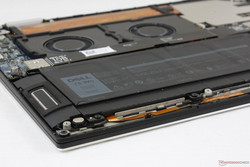
Sound quality from the dual 1 W speakers is passable but clearly lacking in bass and range. Microphone measurements show that lower frequencies are poorly reproduced and music subsequently suffers from a treble-heavy "tin can" quality that's not uncommon on cheaper notebooks. Maximum volume is loud enough to fill a small-medium conference room but it will also cause the palm rests to vibrate slightly.
The system is supposed to come with the Waves MaxxAudio software pre-installed according to the product page not unlike on the XPS 15 9560. Strangely, our unit is inexplicably lacking this software.
Dell XPS 15 9575 i5-8305G audio analysis
(-) | not very loud speakers (68.1 dB)
Bass 100 - 315 Hz
(-) | nearly no bass - on average 16.7% lower than median
(±) | linearity of bass is average (11.2% delta to prev. frequency)
Mids 400 - 2000 Hz
(+) | balanced mids - only 4.5% away from median
(+) | mids are linear (6.9% delta to prev. frequency)
Highs 2 - 16 kHz
(+) | balanced highs - only 2.8% away from median
(±) | linearity of highs is average (8.4% delta to prev. frequency)
Overall 100 - 16.000 Hz
(±) | linearity of overall sound is average (23% difference to median)
Compared to same class
» 80% of all tested devices in this class were better, 5% similar, 15% worse
» The best had a delta of 5%, average was 17%, worst was 45%
Compared to all devices tested
» 68% of all tested devices were better, 6% similar, 27% worse
» The best had a delta of 4%, average was 24%, worst was 134%
Apple MacBook 12 (Early 2016) 1.1 GHz audio analysis
(+) | speakers can play relatively loud (83.6 dB)
Bass 100 - 315 Hz
(±) | reduced bass - on average 11.3% lower than median
(±) | linearity of bass is average (14.2% delta to prev. frequency)
Mids 400 - 2000 Hz
(+) | balanced mids - only 2.4% away from median
(+) | mids are linear (5.5% delta to prev. frequency)
Highs 2 - 16 kHz
(+) | balanced highs - only 2% away from median
(+) | highs are linear (4.5% delta to prev. frequency)
Overall 100 - 16.000 Hz
(+) | overall sound is linear (10.2% difference to median)
Compared to same class
» 7% of all tested devices in this class were better, 2% similar, 91% worse
» The best had a delta of 5%, average was 18%, worst was 53%
Compared to all devices tested
» 4% of all tested devices were better, 1% similar, 94% worse
» The best had a delta of 4%, average was 24%, worst was 134%
Energy Management
Battery Life
Users can expect 9.5 hours of continuous web surfing when set to the Balanced power profile and a backlight brightness of 150 nits (setting 5/10). This is about two hours longer than the XPS 15 9560 when subjected to similar WLAN conditions which is impressive considering that the XPS 15 9560 integrates a larger battery (97 Wh vs. 75 Wh). Dell advertises a runtime of 15 hours, but we are unable to reach anywhere near this claim even when idling on desktop on the lowest brightness setting and with the Power Saver profile active.
Generic or third party USB Type-C chargers can be used to charge the XPS 2-in-1 so long as the output is at least 45 W. In other words, the typical smartphone wall adapter will not work while a USB Type-C charger designed for a laptop should work if needed. A pop-up message will warn users that the battery will slowly drain during higher loads since the AC adapter alone is insufficient.
| Dell XPS 15 9575 i5-8305G i5-8305G, Vega M GL / 870, 75 Wh | Dell XPS 15 9560 (i7-7700HQ, UHD) i7-7700HQ, GeForce GTX 1050 Mobile, 97 Wh | HP Spectre x360 15t-bl100 i5-8550U, GeForce MX150, 79.2 Wh | Apple MacBook Pro 15 2017 (2.9 GHz, 560) i7-7820HQ, Radeon Pro 560, Wh | LG Gram 15Z975 i5-8250U, UHD Graphics 620, 60 Wh | Dell Inspiron 15 7000 7577 i5-7300HQ, GeForce GTX 1060 Max-Q, 56 Wh | |
|---|---|---|---|---|---|---|
| Battery runtime | 11% | 36% | 3% | 36% | -2% | |
| Reader / Idle (h) | 11.1 | 13.9 25% | 15.6 41% | 18 62% | 11 -1% | |
| WiFi v1.3 (h) | 9.4 | 7.2 -23% | 8.5 -10% | 11.3 20% | 7.3 -22% | 6.9 -27% |
| Load (h) | 1.3 | 1.7 31% | 2.3 77% | 1.1 -15% | 2.2 69% | 1.6 23% |
| Witcher 3 ultra (h) | 1.3 |
Pros
Cons
Verdict
The XPS 15 9575 is supposed to translate the standard XPS 15 9560 into a formidable convertible without sacrificing what makes the original so popular. From this perspective, the new XPS is a success as it certainly feels like a classic XPS 15 in terms of quality and rigidity but with the added versatility of a 2-in-1 form factor. It's good to see that the chassis remains as strong as ever in the transition to a thinner design. If you love the XPS 15 9560, then the XPS 15 9575 will feel very familiar.
Performance-wise, the Core i5-8305G CPU and Radeon RX Vega M GL GPU are comparable to the Core i7-7700HQ and GTX 1050, respectively, often by just single-digit percentage points in benchmarks. Dell is absolutely aware of this as the current XPS 15 9560 configuration with the i7-7700HQ CPU and GTX 1050 GPU retails for exactly the same price of $1500 USD as our XPS 15 9575 configuration but with twice the RAM (8 GB vs. 16 GB) and twice the storage (256 GB vs. 512 GB). Thus, there's no question that users are paying a premium for the convertible form factor, touchscreen, and unique Kaby Lake-G SoC of the XPS 15 9575. We've queried Dell multiple times on a potential Kaby Lake-R or GeForce version of the XPS convertible, but the focus at the moment is solely on providing the best Kaby Lake-G experience possible and the 9575 has certainly met our expectations on that front.
The price and spec differences are obvious, but what about temperatures, noise, and battery life? To our surprise, the XPS 15 9575 runs cooler, quieter, and sometimes longer than the XPS 15 9560 when browsing, word processing, or gaming. It's an achievement worth praising because the XPS convertible is on par with the XPS 15 in terms of CPU and GPU power while simultaneously being thinner and with a smaller battery.
The forced Maglev keyboard is hit or miss. It's a significant change from the XPS 15 9560 and it doesn't work as well for the smaller half-sized Arrow keys or Function keys compared to the main QWERTY keys. We believe that an integrated NumPad like on the 2018 Spectre x360 15 would have been far more useful for productivity. The moderate-heavy ghosting, full reliance on USB Type-C, presence of pulse-width modulation, heavy weight, spongy trackpad, fixed RAM, fingerprint-prone surfaces, and more limited storage options round up the list of notable disadvantages. Gaming capabilities are good but far behind the GTX 1050 in some titles where further optimization is required.
Dell's latest XPS convertible is home to a lot of firsts and nearly all are home runs. Kaby Lake-G is comparable to the GeForce GTX 1050 and Core i7-7700HQ while being cooler and quieter than the XPS 15 9560. On the other hand, the Maglev keys are a mixed bag and the NVMe Toshiba SSD is generally slower than an equivalent Samsung PM961. Be ready to carry USB Type-C adapters everywhere you go and a cleaning cloth to keep those dark keys free of grease.
Dell XPS 15 9575 i5-8305G
- 04/22/2018 v6 (old)
Allen Ngo




